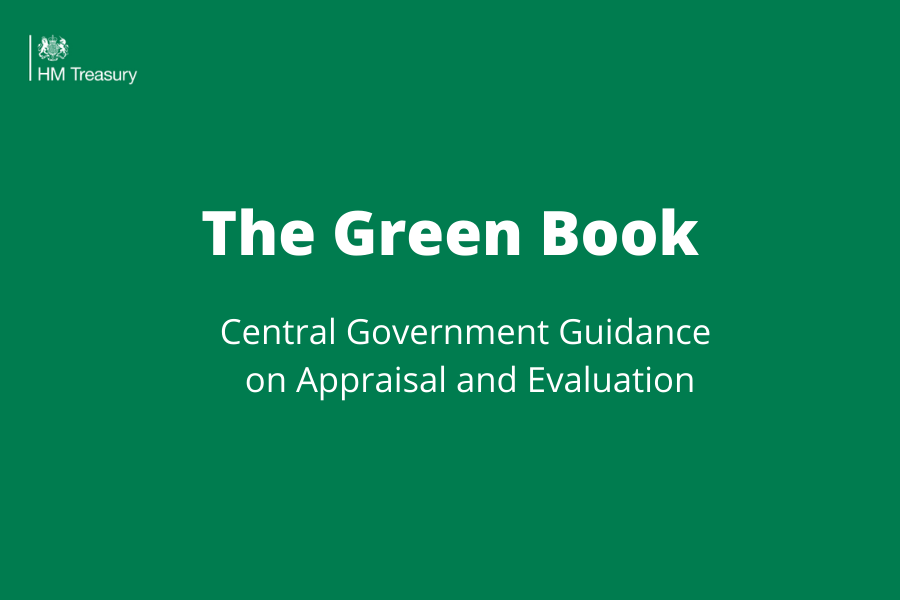
Professor Andrew Brown discusses the Green Book Review, how benefit-cost ratios continue to dominate appraisals, and how systems thinking in economics can act as an aid to implementing the Green Book Review.
How should government ensure the ‘value for money’ of the public purse?
Recently Bec Riley and I ran a workshop on this question at the wonderful ‘Exploring Economics’ conference attended by nearly 400 civil servants. We discussed how valuation practices across local, regional, and national governments are deficient – and how strategically vital green and place-based investments are being held back as a result.
Exhibit A of our evidence was a perhaps unlikely source: HM Treasury’s (HMT) comprehensive Nov 2020 Review and refresh of its UK ‘value for money’ guidance, called the Green Book. The good news is that HMT provides a profound basis on which to change current practices for the better. The bad news is that HMT’s guidance (in principle binding on all who spend public money) is being fundamentally misinterpreted. In this blog, I will introduce systems thinking in economics as an aid to implementing HMT’s Green Book Review and our proposed way forward.
The HMT 2020 Green Book Review and refresh
HMT’s Review is hard-hitting. It says that appraisal of value for money at local, regional and national levels is too focused on measurable monetary quantities. A culture of appraisal has arisen whereby the ‘be all and end all’ is the highest measurable monetary benefit in relation to measurable monetary cost, i.e. the highest ‘benefit-cost ratio.’ (BCR) As a result ‘black box’ models, torn from strategic context, are being commissioned to churn out spuriously precise and inflated BCRs.
HMT’s Review recommends that current practices be rebalanced to reflect strategic policy goals. The HMT guidelines start with strategy (the ‘strategic case.’) If a proposed intervention does not deliver on strategic objectives then it is not an option. Strategic objectives must retain priority in subsequent stages of appraisal. So, in the ‘economic case,’ where a BCR is calculated, the best value for money option may have a low BCR if its strategic benefits cannot be monetised.

But appraisal practices have been slow to change
City-REDI’s review reveals that appraisal practices continue to fetishise the BCR, overlooking strategic considerations. This finding is deeply worrying because it means that vital strategic investments are being held back due to HMT guidelines not being followed. At iCASP and Y-PERN we have focused on the role that economics (another perhaps unlikely source of help) can play in improving appraisal practices. Let me share our key insights, starting with the economics behind the BCR.
The role of economics
According to economic theory, the calculation of a BCR is meaningful when appraising interventions that impact one or a few related markets, not the whole economy. This restricted scale ensures a direct relation between the calculated BCR of an intervention and its impact on ‘utility’ or ‘social welfare.’ (See end note 1)
The direct relation of a BCR to social welfare is what motivates cost-benefit analysis. Given this direct relation, it makes good sense to, for example (1) monetise impacts for which there are no market prices, such as travel time savings or pollution; (2) monetise wider impacts outside the market of focus.

However, where interventions feature complex interconnections across many markets, cost-benefit analysis is inapplicable. HMT’s Review gives an example of the policy goal of net-zero UK emissions. This goal requires strategically coordinated intervention across the economy and society. (See end note 2) To value such ‘transformational’ change, a single BCR metric, if it could be calculated at all, would be meaningless because it would not measure utility or social welfare. The same holds for other transformational goals such as ‘levelling up’ the UK.
Accordingly, HMT’s Review says that analysis of transformational change should precede cost-benefit analysis. It recommends a robust, mixed-methods and interdisciplinary process of evidence review, stakeholder engagement and deliberation, incorporating strategic assessment of transformational change, prior to BCR calculation.
How, in this process, is transformational change to be valued?
Working with HMT and many other stakeholders and academic disciplines, economists have contributed a systems approach to value transformational change. (see End note 3)
Consider the following insights.
Insights from systems thinking in economics
Firstly, processes of creating and capturing value drive transformational change. Stakeholders are typically inserted at various points of such a process, for example, initial financing, sourcing raw materials, hiring inputs, producing (through many stages), distributing, selling, consuming, disposing / recycling, long-term funding and reinvesting. A group exercise mapping relevant value flows may therefore be helpful in stakeholder engagement, explaining chains of cause and effect in the system.
Secondly, value is multidimensional (in line with the finding above that money cannot be the sole measure of value when assessing transformational change.) For example, environmental and social value are dimensions of value alongside monetary value. (See end note 4) Systems thinking in economics thus supports the use of multidimensional indices and dashboards.

For this approach, items have both ‘exchange-value’ (measured by money) and ‘use-value’ (usefulness). In this view, meeting needs, and so the measurement of use-value, cannot be uniquely reduced to a one-dimensional metric such as money or subjective utility. This argument reflects a switch away from a utilitarian to a ‘eudemonic’ philosophy of value and wellbeing.
Thirdly, value creation and capture are not just economic but also political. We must ask: Who creates value? For whom? Who pays? For example, one interdisciplinary application of economics found that Local Authorities pay disproportionately for plastic packaging waste management, supporting DEFRAs introduction of Extended Producer Responsibility.
Fourthly, there is a mutual influence between the material and social aspects of provisioning. For example, material provision of better cycle lanes may increase cultural preferences for cycling, which, in turn, may stimulate cycle lane provision.
Fifthly, and synthesising the above points, there are distinct systems of provision of each kind of good or service, each requiring bespoke analysis (so waste, transport, housing, etc. each have unique qualities). Yet, these systems are also interrelated. For example, there are interdependencies between built infrastructure systems, such as energy and transport; between natural and built systems; and within natural systems. The economy in this sense is a system of systems.
Sixthly, HMT’s Review recognises decision-making under deep uncertainty (not quantifiable risk) as an element of transformational change. Deep uncertainty is addressed by systems thinking in economics, underpinning an adaptive approach to appraisal.
The case for green and blue infrastructure
What does all this mean in practice? Take the example of ‘green and blue infrastructure’ (GBI) which includes ‘grey to green’ schemes and nature-based solutions of all kinds.
GBI has multiple environmental, health and cultural benefits, and is integral to the Government’s transformational net-zero strategy. Yet, iCASP found that the available tools of quantification and monetary valuation of GBI benefits are in their relative infancy. Tools and procedures for valuation of travel time savings are much more thoroughly tested and standardised than those for GBI.
Undue emphasis on the BCR therefore results in GBI losing out to interventions with more readily and reliably monetised benefits. The example of GBI thereby underlines the urgency of HMT’s Review recommendation that:
Strategic benefits, (e.g. of GBI) thoroughly evidenced and argued for in the strategic case, must continue to be prioritised in the economic case even if they cannot be reliably captured in a BCR.
Conclusion and next steps: join our workshop programme!
It is well over two years since the HMT’s Green Book Review. Appraisal practices have been slow to change. Clearly, training and resourcing of Green Book practitioners is needed and indeed much has been done already in this regard, initiated by HMT’s Review.
We believe Universities also have a key role to play. The Green Book is exemplary in how it builds upon an academically rigorous evidence base. Universities are anchor institutions with huge expertise and convening power to support the requisite change in appraisal practices.
The workshop held at the Exploring Economics conference will therefore initiate a series of future workshops across the UK.
Supported by HMT’s ‘Green Book User Group,’ these future regional and national workshops will be designed to help practitioners build an appraisal system that can unlock green and place-based investment across the UK. We look forward to seeing you there!
End notes
- In the jargon, (please skip if you prefer!) cost-benefit analysis is a ‘partial equilibrium’ analysis focusing on ‘marginal’ change. One reason (amongst many) why non-marginal change destabilises the link between the BCR and utility is the ‘diminishing marginal utility of income’: successive increases in my income (e.g. through growth impacts of a public investment programme) will, after a threshold point is reached, lower the utility I attach to additional income.
- In Green Book terms coordination requires that an individual ‘project’ fit within the ‘programme’ of which it is part; and an individual programme within a wider ‘strategic portfolio.’
- One strand originates with the iBUILD project on infrastructure business models – see HMT’s Valuing Infrastructure Spend and academic research referenced therein, e.g. Brown and Robertson (eds) (2014).
- (Warning: more jargon!): For this approach, items have both ‘exchange-value’ (measured by money) and ‘use-value’ (usefulness). In this view, meeting needs, and so the measurement of use-value, cannot be uniquely reduced to a one-dimensional metric such as money or subjective utility. This argument reflects a switch away from a utilitarian to a ‘eudemonic’ philosophy of value and wellbeing.
Professor Andrew Brown, Y-PERN Academic Director, UPEN Co-Chair and iCASP GBI Business case project lead.
Disclaimer:
The views expressed in this analysis post are those of the authors and not necessarily those of City-REDI / WMREDI or the University of Birmingham.
